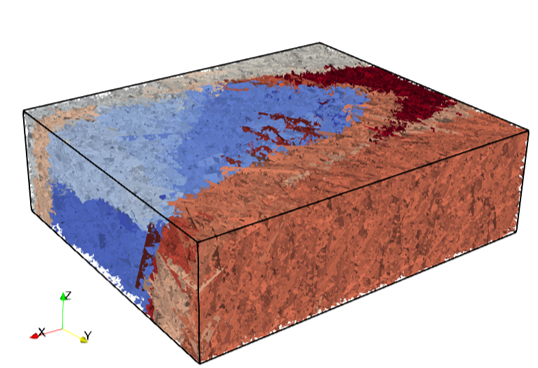Site modelling using DFN.lab: DFN generation
Discrete Fracture Network (DFN) Site Modeling for the Forsmark Nuclear Waste RepositoryBuild a DFN model for the Forsmark site
Context
The Forsmark site in Sweden, characterized by sparsely fractured crystalline rock, has been selected as the future location for a deep geological repository for nuclear waste. Highly detailed, Discrete Fracture Network (DFN)-based site models are essential for ensuring post-closure safety and guiding construction efforts. DFN models offer the most accurate representation of the fractured system and the geological context, making them indispensable for assessing the long-term safety and feasibility of the project.
For this project, a domain of 3780×3200×1110 meters has been defined. The domain includes several sub-volumes, known as fracture domains, where the fractures display different statistical properties. It also encompasses tens of deformation zones, such as large faults, with predefined shapes and locations. The initial step in site modeling involves constructing a numerical model of the site using a combination of deterministic information (e.g., fracture domain boundaries and deformation zone locations) and statistical data (DFN models), supplemented by stochastic processes to generate equiprobable realizations, as is standard in DFN methodologies. In subsequent phases, and for safety assessment purposes, the model will be employed to simulate fluid flow and contaminant transport, predicting the movement of contaminants from the deposition holes through the geological barrier formed by the crystalline bedrock.
Project results
We used the DFN.lab platform to create a DFN numerical analog of the selected domain. This model adheres to all input specifications and will serve as the foundation for subsequent flow and transport simulations.
The stochastically generated DFN model accurately reproduces the input statistics and reflects the spatial division into various fracture domains. Deformation zones are integrated as large, non-planar 2D surfaces within the model.
The final model is delivered as a Jupyter notebook, fully parametrized for ease of use. Users can easily control the resolution of the DFN, specifically the lower cut-off size of the generated fractures, while maintaining statistical consistency across larger fractures. Additionally, a sensitivity analysis of the DFN resolution was performed to evaluate the model’s performance and accuracy.

Fracture domains geometry

DFN realization